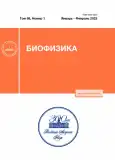Paracrine effects of stem cell conditioned medium on production of oxygen reactive species in blood neutrophils in acetaminophen-induced liver failure
- Autores: Temnov A.A1,2, Sklifas A.N1, Zhalimov V.K1, Sharapov M.G1, Fadeev R.S3, Kobyakova M.I3, Kukushkin N.I1, Rogov K.A4
-
Afiliações:
- Institute of Cell Biophysics, Russian Academy of Sciences
- Moscow Institute of Physics and Technology
- Institute of Theoretical and Experimental Biophysics, Russian Academy of Sciences
- Research Institute of Human Morphology
- Edição: Volume 68, Nº 1 (2023)
- Páginas: 87-97
- Seção: Articles
- URL: https://journals.rcsi.science/0006-3029/article/view/144407
- DOI: https://doi.org/10.31857/S000630292301009X
- EDN: https://elibrary.ru/OAFUWG
- ID: 144407
Citar
Texto integral
Resumo
Palavras-chave
Sobre autores
A. Temnov
Institute of Cell Biophysics, Russian Academy of Sciences;Moscow Institute of Physics and TechnologyPushchino, Moscow Region, Russia, Dolgoprudny, Moscow Region, Russia
A. Sklifas
Institute of Cell Biophysics, Russian Academy of SciencesPushchino, Moscow Region, Russia, Dolgoprudny, Moscow Region, Russia
V. Zhalimov
Institute of Cell Biophysics, Russian Academy of SciencesPushchino, Moscow Region, Russia, Dolgoprudny, Moscow Region, Russia
M. Sharapov
Institute of Cell Biophysics, Russian Academy of SciencesPushchino, Moscow Region, Russia, Dolgoprudny, Moscow Region, Russia
R. Fadeev
Institute of Theoretical and Experimental Biophysics, Russian Academy of SciencesPushchino, Moscow Region, Russia
M. Kobyakova
Institute of Theoretical and Experimental Biophysics, Russian Academy of SciencesPushchino, Moscow Region, Russia
N. Kukushkin
Institute of Cell Biophysics, Russian Academy of Sciences
Email: nikukushkin@mail.ru
Pushchino, Moscow Region, Russia, Dolgoprudny, Moscow Region, Russia
K. Rogov
Research Institute of Human MorphologyMoscow, Russia
Bibliografia
- A. M. Larson, Clin. Liver Dis., 11, 525 (2007).
- M. R. McGill, M. R. Sharpe, C. D. Williams, et al., J. Clin. Invest., 122, 1574 (2012).
- H. Jaeschke, C. D. Williams, A. Ramachandran, et al., Liver Int., 32, 8 (2012).
- Y. Ishida, T. Kondo, A. Kimura, et al., Eur. J. Immunol., 36, 1028 (2006).
- Z. X. Liu, D. Han, B. Gunawan, et al., Hepatology, 43, 1220 (2006).
- P. E. Marques, S. S. Amaral, D. A. Pires, et al., Hepatology, 56, 1971 (2012).
- C. Cover, J. Liu, A. Farhood, et al., Toxicol. Appl. Pharmacol., 216, 98 (2006).
- H. S. Hou, C. L. Liao, H. K. Sytwu, et al., PLoS One, 7, e44880 (2012).
- J. A. Lawson, A. Farhood, R. D. Hopper, et al., Toxicol. Sci., 54, 509 (2000).
- C. D. Williams, M. L. Bajt, A. Farhood, et al., Liver Int., 30, 1280 (2010).
- C. D. Williams, M. L. Bajt, M. R. Sharpe, et al., Toxicol. Appl. Pharmacol., 275 (2), 122 (2014).
- C. D. Williams, A. Farhood, and H. Jaeschke, Toxicol. Appl. Pharmacol., 247, 169 (2010).
- J. X. Wang, C. Zhang, L. Fu, et al., Toxicol. Lett., 265, 38 (2017).
- W. Yang, Y. Tao, Y. Wu, et al., Nat. Commun., 10 (1), 1076 (2019).
- A. Temnov, K. Rogov, V. Zhalimov, et al., Hepat. Med., 11, 89 (2019).
- A. A. Temnov, K. A. Rogov, A. N. Sklifas, et al., Mol. Biol. Rep., 46 (3), 3101 (2019).
- H. Yagi, A. Soto-Gutierrez, N. Navarro-Alvarez, et al., Mol. Therapy, 18 (10), 1857 (2010).
- F. A. von Meijenfeldt, L. C. Burlage, S. Bos, et al., Liver Transpl., 24 (12), 1716 (2018).
- T. D. Schmittgen and K. J. Livak, Nat. Protoc., 3 (6), 1101 (2008).
- J. Almkvist, C. Dahlgren, H. Leffler, et al., J. Immunol., 168 (8), 4034 (2002).
- M. T. Elola, M. E. Chiesa, and N. E. Fink, Comp. Biochem. Physiol. B. Biochem. Mol. Biol., 141 (1), 23 (2005).
- J. Liu, M. Jiang, Q. Jin et al., Front. Pharmacol., 12, 723881 (2021).
- F. A. von Meijenfeldt, R. T. Stravitz, J. Zhang, et al. Hepatology, 75 (3), 623 (2022).
- R. D. Gray, C. D. Lucas, A. MacKellar, et al., J. Inflamm. (Lond.), 10 (1), 12 (2013).
- B. Saberi, M. Shinohara, M. D. Ybanez, et al., Am. J. Physiol. Cell Physiol., 295 (1), C50 (2008)
- B. Saberi, M. D. Ybanez, H. S. Johnson, et al., Hepatology, 59 (4), 1543 (2014).
- B. W. Lee, B. S. Jeon, and B. I. Yoon, J. Appl. Toxicol., 38 (7), 1008 (2018).
- T. Shimizu, R. Abe, H. Nakamura, at al., Biochem Biophys Res Commun., 264 (3), 751 (1999).
- A. Kudrin and D. Ray, Immunol. Cell Biol., 86 (3), 232 (2008).
- H. Lue, R. Kleemann, T. Calandra, et al., Microbes Infect., 4, 449 (2002).
- J. Yodoi, H. Nakamura, and H. Masutani, Biol. Chem., 383, 585 2002.
- A. Novak, G. D. Carpini, M. L. Ruiz, et al., J. Pharm. Sci., 102 (10), 3830 (2013).
Arquivos suplementares









